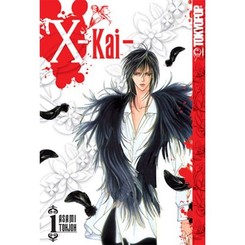Review
by Theron Martin,X-Kai
G.novel 1
| Synopsis: |  |
||
On the surface Kaito appears to be just an ordinary bishonen florist, but in truth he is actually an assassin, one with a reputation for using flowers in his killings. But Kaito is no ordinary cold-blooded killer; he is a compassionate assassin, one who considers the nature of his target before carrying out any job, and one who must look after his sickly younger brother. In this volume the mysterious young lady who passes jobs onto him brings him a mission involving a young blind woman suffering from a terminal disease, a second mission involving eliminating a yakuza boss, and third mission involving a drug dealer – but the last is complicated when an abandoned boy catches Kaito's attention and a copycat killer seems to be preying on high school girls. |
|||
| Review: | |||
The “principled killer” has been a common storytelling theme in media of all kinds for quite some time now. Though he/she kills (this can apply to female leads as well as male ones), he never kills the innocent; only bad guys fall to his hand or those he must kill in self-defense, and even then he's wracked with guilt over the blood on his hands. Quite often killers of this kind are romanticized, as they are lovable for their compassionate and feeling sides while having enough of a hint of danger about them to make them exciting. Put a bishonen look on the killer and you have the perfect hero for a more mature and edgy, although also predictable, shojo manga series. And it's that predictability and slavery to stylistic convention that are the main problems here. The story content just doesn't feel fresh, and except for one minor surprise the first two stories are quite transparent. The third and longest story fares better, as it does have an interesting twist or two, but on the whole the manga feels like it is following a “how to make a brooding, compassionate killer” formula. Sure, the flowers are a novel gimmick, but they aren't anything more than this particular killer's personal panache; a reader would be digging to find any deeper meaning to them. Yes, there is at least some attempt at philosophizing about the meaning of life and death, but nothing deeper than what might be seen in a typical summer blockbuster. Of course there's a child – in this case a confused and damaged young boy – whom the killer sees as his ticket to salvation, and naturally the killer is clever in his methods. And since this is a title aimed at (I'm guessing) late teens female audiences, it shouldn't be any surprise that there's just a bit of homoeroticism as well. True character development is another element sacrificed to style. Manga-ka Asami Tohjoh has the brooding thing down quite well for Kaitaro but that seems to be his only real personality trait. The only other recurring character, the unnamed woman who gives him his jobs, is also a one-trick pony, having no character beyond her sarcasm. Tohjoh does better with secondary characters, as the blind girl in the first story, the girlfriend in the second story, and especially the boy in the third story are all better-defined and more interesting characters than the lead. That usually isn't a good sign for a series completely centered around the lead, however. Tohjoh's artistic style favors long-necked character designs which, for its male studs, are continued with broad-shouldered and impossibly lanky builds. As with the writing, though, this is nothing more than the continuation of a common current trend; there's nothing at all original-looking about these designs. Tohjoh does better with female and child character designs, especially the blind girl and the girlfriend in the second story, but they also uniformly have long, lanky bodies and the women are not very distinguishable from younger adult male characters in the way their faces are drawn. (Of course, this could also be because Kaitaro has such a typically girlish bishonen look about him.) The overall quality of background detail is about average; although a few scenes have a lot of it, it isn't as sharply-defined as in the better manga titles. Graphic content includes two scenes of nudity, another scene where a character is trying to commit suicide, and a few spots of graphic violence and bloody corpses. While it's not a particularly graphic title, there is enough edgy content here to warrant the Older Teens rating. Tokyopop's production of X-Kai does translate most of the sound effects, although so few of them are used in this volume that a reader may not notice. The color cover artwork is the sharpest artwork in the whole volume and very indicative of the interior artwork, so if the cover doesn't work for you then the whole manga probably won't, either. Although the story content is presented in only three “Secrets,” the way the third Secret is structured suggests that it was originally spread over three chapters instead. A brief postscript by the manga-ka is included at the end. X-Kai is a manga aimed squarely at more mature bishonen fans who find the notion of a lovable killer to be sexy. Those outside the target audience are unlikely to find much of interest here. |
| Grade: | |||
|
Story : C
Art : C
+ Has a couple of interesting twists in its third story, handles supporting characters well. |
|||
| Production Info: | ||
|
Full encyclopedia details about Release information about |
||